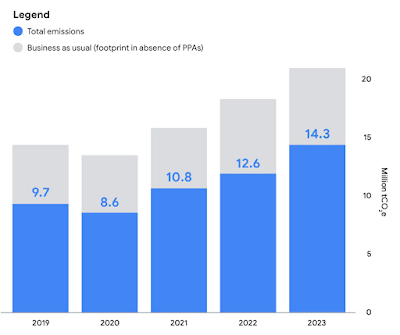While the ruling technocracy loves to tout its record and promote the anti-greenhouse gas mantra when it comes to their own operations, a recent release from Google (the host company of this blog) shows us that the rubber does not always meet the road when it comes to environmental stewardship.
In its 2023 Environmental Report:
...Google's Chief Sustainability Officer Kate Brandt and Senior Vice President of Learning and Sustainability Benedict Gomes state the following in the introductory Executive Letter:
"Our annual Environmental Report offers a deep dive into our efforts to harness technology—particularly AI—to drive positive environmental change and operate our business sustainably. This year, we’re also offering a new experimental AI chatbot, powered by NotebookLM, to help summarize key findings, clarify complex topics, and explore the details about our environmental work."
In fact, one section in the report outlines Google's use of "AI for sustainability":
"We know that scaling AI and using it to accelerate climate action is just as crucial as addressing the environmental impact associated with it."
...and in these graphics:
Google boldly claims that AI has the:
"…potential to help mitigate 5–10% of global greenhouse gas (GHG) emissions by 2030. "
Google also claims the following:
"We have a bold goal to reach net-zero emissions across all of our operations and value chain by 2030, supported by a goal to run on 24/7 CFE (carbon-free energy) on every grid where we operate. In addition, we’re working to advance water stewardship, build a circular economy, and restore and enhance nature and biodiversity. This year’s report shows how we continue to make progress across all of these areas:
1.) Ten of our grid regions 10 achieved at least 90% CFE, and even with our total electricity load increasing across our data centers, we maintained a global average of 64% CFE. We also celebrated a first-of-a-kind enhanced geothermal project now delivering CFE to the grid
2.) We signed contracts to purchase approximately 4 gigawatts of clean energy generation capacity 11 in locations such as Texas, Belgium, and Australia—more than in any prior year."
All of this sounds just magical, doesn't it. Unfortunately, this is where reality doesn't meet expectations. Google's target is to "reduce 50% of its combined Scope 1, 2 (market-based), and 3 absolute greenhouse gas (GHG) emissions by 2030." Unfortunately, that goal looks increasingly unlikely as shown on this graphic from the report:
Google's total GHG emissions in 2023 increased by 13 percent on a year-over-year basis and a 48 percent increase when compared to 2019. The company's total emissions of 14,314,800 tonnes of CO2 equivalent consists of the following:
Notice the large Scope 2 emissions. The main source of these emissions is purchases of electricity for the company's data centres and offices despite the fact that the company claims that its data centres are among the most efficient in the world. The company will procure carbon-free energy to reduce its Scope 2 emissions with the goal of running on carbon-free energy 24 hours a day, seven days a week by 2030. In 2023, the company's data centres and offices ran on carbon-free energy for 64 percent of its electricity use on an hourly basis, the same percentage as in 2022 ranging from 0 percent in Qatar and Saudi Arabia and 4 percent in Singapore to 100 percent in Canada (thanks to Hydro-Quebec) and 98 percent in Finland.
While artificial intelligence is being touted as the panacea to the global climate crisis, as Google is finding out, such is not the case. Here is a graphic from my favourite globalists at the World economic Forum have observed the conundrum between AI and energy usage as shown here:
Here's an example of the AI/global environment conundrum from Tom’s Hardware:
"Nvidia's H100 GPU is projected to consume approximately 3,740 kilowatt-hours (kWh) of electricity annually. Assuming that Nvidia sells 1.5 million H100 GPUs in 2023 and two million H100 GPUs in 2024 and that there is a 61 percent annual utilization, there will be 3.5 million such processors deployed by late 2024. In total, they will consume a whopping 13,091,820,000 kilowatt-hours (kWh) of electricity per year, or 13,091.82 GWh."
This is roughly the annual power consumption of entire nations like Georgia, Guatemala and Lithuania and that the 3.76 million Nvidia GPU shipments could consume as much as 14.38 TWh, the same annual power needs as 1.3 million American households...for one model of a GPU.
The International Energy Agency projects that global electricity demand from AI, data centres and cryptocurrencies could reach more than 1000W TWh in 2026, a 217 percent increase from 2022, equivalent to the electricity consumption of Japan and you can assure yourself that much of this growth in demand will NOT be fulfilled with renewable sources.
With Big Tech and Google in particular spending untold hundreds of billions of dollars on accelerating AI development and increasing both the speed and power consumption of GPUs, it's increasingly looking like the move to AI is going to be the global energy/environment canary in the coal mine and most certainly not the solution to the problem (that they are creating).











No comments:
Post a Comment